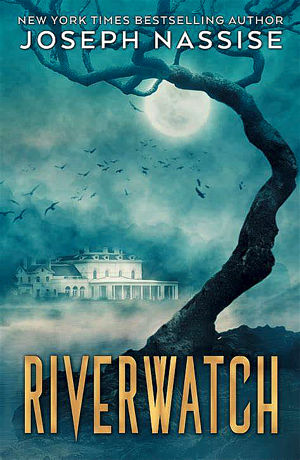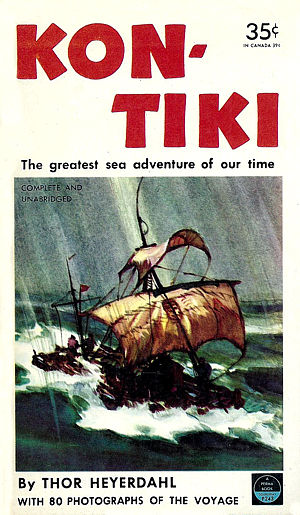 |
 |
Review by E.C. McMullen Jr. |
|

USA Release: Dec. 27, 2000 by Joseph M. Nassise Barclay Books, llc $15.95 TPB ISBN 1931402191 |
|||
There was a time when I was younger, that I would read a story that started off bad, and I would keep reading in hopes that it would get better. I felt the same about movies and pretty much everything else in life - except for relationships. Those start off good and grow steadily worse.
What I found with books and movies though was that if the tale started off bad it wasn't going to get any better, in fact it was going to get worse. This is especially true for horror movies and stories. If the writer/director doesn't know how to start the tale they damn sure aren't going to know how to finish it. A case in point is Dario Argento. His movies have such wonderful, intriguing middles. That guy can write middles like it's nobody's business. But his beginnings and endings are for the birds.
This brings me to Joe Nassise's new novel RIVERWATCH. For those who enjoy the Varmint In The Basement style of stories, this is the one for you. We have the varmint who escapes from his centuries old curse to once again wreak havoc on a small, out of the way community. Why does this happen to those small out of the way towns all the time, you ask. Why not big cities? Why only small towns?
My answer is: It already happened in the big cities, and the violence and crime you see there is a direct result of the evil that has corrupted the place. But I digress.
There is fun to be had in Joe's RIVERWATCH so let me address those first and I'll return to my introductory thought in a moment.
RIVERWATCH involves the last gathering of the three intelligent species that once ruled the earth together.
The Elders - who were wise and long lived
The Nightshades - who were powerful and long lived
The Humans - who were food for the Nightshades.
The Elders (who look just like us) had a special fondness in their hearts for primitive humans (possibly because we looked just like them) and taught us how to grow and achieve.
The Nightshades didn't like the idea of their cattle getting smart enough to outwit them. Especially since they were being trained by The Elders who looked so much like the humans in the first place. I can imagine the confusion this must have caused for the Nightshades:
Elder: "Take your claws out of me you damn dirty Nightshade!"
Nightshade: "Oh shit! Not another freaking Elder again! Can't you guys wear hats or something?"
So the Nightshades waged war against the Elders. This was fine by the Elders since they didn't like the Nightshades eating their, for lack of a better term, pets (again, that's us).
After the great war which largely ended thousands of years ago, there was naught left but us humans. We were the cockroach leftover of the world war between the two dominant species. Though the Elders taught us primitive technology, we really exploded after the fall of the Roman Empire and have been going gangbusters ever since. In fact, our current high technology far outstrips our emotional and physical growth and that is when the Nightshade return. You see, there is one of them that still remains, bound by a curse. The varmint is released by some drunken lazy slob (it's always some asshole isn't it?) who had no idea what he was doing other than being a thief, and the Nightshade is among us by chapter 10.
The Nightshade soon sets about eating us and rounding up his human cattle and in RIVERWATCH we soon realize that all our advanced technology isn't going to help us more than our one common human stupidity - denial - is going to get us killed.
We have a trio of heroes who know what's going on in the form of:
SAM - who designs role playing games, writes, and supplements his income working at the local hospital. His two closest friends are:
JAKE - who owns a construction company that first unearths the home of the cursed varmint.
KATE - who is Sam's friend and Jake's girlfriend. She is largely the assistant throughout this story to the other two men.
But they can't tell anyone what they know because who would believe them?
Other interesting characters come into play, like Gabriel. An old man who lives in the hospital / nursing home (slowly dying there) and tells Sam fascinating stories. You realize from the start that there is more to Gabriel than meets the eye.
Another major character is Sheriff Damon. He is the one who has to deal with the rash of grisly (if not artistically creative) murders. His detective work brings him ever closer to the circle of the three friends.
Finally there is Moloch, who is truly free for the first time in centuries. Good for him but bad for us.
TRIVIA After reading this review, author Joe Nassise wrote to say: "Thanks for that great review! I don't think I've mentioned before that the two places I read the most reviews are your site and my weekly edition of Hellnotes. In both places, the reviews are what I call real reviews - they tell you what the reader liked AND disliked about the story, which is just what a review should do, in my opinion." |
Nassise builds his characters well, rounding them out and making them behave in unexpected, but entirely plausible ways. When they do behave in those ways we didn't expect, their motives are both clear and rational under the extraordinary circumstances they are living through.
Altogether this is a wonderful read and an excellent retelling of the old Varmint In The Small Town mythos.
The problems this book has starts in its very first chapter. There is a ham-handed beginning to the story involving contrived suspense. In the opening scene, a worker of Jake's, Rick, tells his boss that the crew needs him to see something. He won't tell him what it is, but he needs to come down and look at it.
Jake looked at Rick and received a shock. His friend's lips were pressed tightly together. The tension in his jaw was easy to see in spite of the man's effort to hide it. His usually ruddy face had gone the sickly gray of anchovies and the cheerful light in his eyes had dulled to a lusterless sheen.
As it turns out, his men had been pumping water out of the celler of the old Blake manor and came across a stone slab. Rick thought it might be a cover to a storeroom so he had one of his men break a corner off the stone slab. With a flashlight they could see stairs leading down to somewhere.
So Rick thinks it's an old storeroom and he finds that there are steps leading down. That's what freaks Rick's shit out. Why wouldn't you have steps leading down to a store room? You are already in the cellar! There is no believable reason ever offered for why Rick goes all freaky for finding the stone slab - I would have accepted premonition, psychic connection, anything - other than the fact that he just is that's all.
All in all the first chapter is a bad beginning, but I wouldn't want you to read through the first few pages and put the book back, thinking it a lemon. There is a great tale to be found in RIVERWATCH and the story gets better by leaps and bounds, chapter by chapter.
To be sure, this is Joe's first novel and there are the noticable stumblings of a beginner throughout the tale. Gaping plot holes? Yep. There is a reference to Erich von Däniken's (CHARIOTS OF THE GODS?) book about Easter Island from Sam:
"Like who built the statues on Easter Island? They've stood there for centuries yet no one knows one iota about the people who built them or why they were built in the first place."*
Sam waxes on about how we cannot duplicate, even today, the mathematical precision of the pyramids of Egypt.**
Sam also uses, as credibility for the plot, Homer's version of Atlantis.***
Lovecraft and Barker as well as other writers have avoided these pitfalls by making their varmints and the accompanying mythos out of whole cloth rather than be trapped by myth, history, or reality.
Metaphors could have been better considered ("the sickly gray of anchovies?") and a little more research would have helped this story immensely, but overall this is a fine read and clearly one of the best first novels I've ever come across. In RIVERWATCH, Joseph Nassise displays a solid storytelling sense, plot and character development, and a finely crafted balance of both action and people driving the tale forward. Nothing is wasted on fictional sidestreets or other literary meanderings. RIVERWATCH moves with the same powerful intent and grace as the Nightshade itself.
Because of its flaws RIVERWATCH loses 2 Bookwyrms. Because of the wonderful storytelling, it gets 3 BookWyrms. In RIVERWATCH, Joe demonstrates his potential for becoming one of the greatest Horror writers of our time.
3 BookWyrms



This review copyright 2001 E.C.McMullen Jr.
| GET SOME CLOTHES ON | |
*
Scientist and adventurer, Thor Hyderdahl (a REAL Indiana Jones type), found out in the early 20th century. He and his crew sailed on their balsa wood raft in 1947 for a 110 day voyage from Peru to the Polynesian island of Raroia. He even filmed the Easter Island natives building a stone head (called a moai) and setting it into place (a team from NOVA repeated this in the early 1980s). He made copious notes, audio and film recording, and wrote it all down in his books KON TIKI and AKU-AKU. Kon-Tiki alone was translated into 67 languages and sold over 20 million copies at its height (remains in print after 64 years!). The documentary film was released in 1950. Erich von Däniken never went to the islands, so never asked the natives, and never cared since, by his own admission, he's a racist. He just took it on faith that no one without white skin could possibly know anything like making the great heads of Easter Island (most of which have bodies buried beneath ground level to keep the heads from tipping over): Must have been those pesky ol' outer space aliens! Erich and his kookery fell off the map of popularity when, in 1978, NOVA did an entire show proving how Erich was not only a phony, but when confronted, could not produce an excuse for his obvious lies. That same show also demonstrated how the Egyptians built their pyramids through trial and error - which remains part of the tour package when you holiday in Egypt - not divine knowledge. It also showed how Aztec / Inca / Mayan pyramids are nothing at all like their Egyptian counterparts, except for their shape, which is a fundamental geometric shape in the first place - like balls and cubes. The Accuracy of the Aztec Calender? The Aztec stargazers watched the skies and the earth from generation to generation without worry over whether or not the earth was the center of the universe or whether the church was going to torture them and rape and burn their children for being witches. Then they based their calender on the Mayan one. Technology among these people was both tolerated and encouraged. For a big chunk of European history, under Christian domain, it was not. ** Building massive stone pyramids the way the ancient Egyptians did it would be a piece of cake, the math involved in putting a functioning unmanned communications or weather satellite into orbit is magnitudes more difficult. Giant stone pyramids are just pointless and prohibitively expensive. Oh, the things you can make people do when you crack the whip and tell them that they will be rewarded in "The Next Life". *** Where Homer painted the Atlanteans as a wonderful, peaceful, and advanced people, years later Plato would portray them as arrogant warmongers, whom the Athenians beat handily in battle. Atlantis was sunk due to the iniquity of these wretched people. It was Plato who gave them the name Atlanteans, though his account of them bears a striking resemblance to Homer's island of Scheria, in his novel, The Odyssey. Such is the mythology. Plato was known to be a spin doctor of his time. He painted two of the most reviled men in Athen's history, Socrates and his student Critias (Plato's uncle), as benign philosophers and story tellers. In truth, Socrates was an anti-social misfit fond of starting arguments and glorifying the actions of the powerful and wealthy as above reproach. Critias was a thug and thief who, during his rule of Athens, ordered whole families slaughtered and their possessions given over to him. |
| FEO AMANTE'S HORROR THRILLER Created by: E.C.MULLEN JR. |
| COME FOLLOW ME @ Amazon |
| ECMJr |
| Feo Blog |
| IMDb |
| Stage32 |
| YouTube |
| Zazzle Shop |


 Sure we do.
Sure we do.